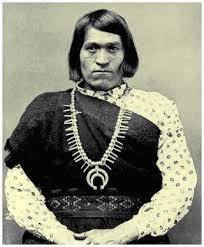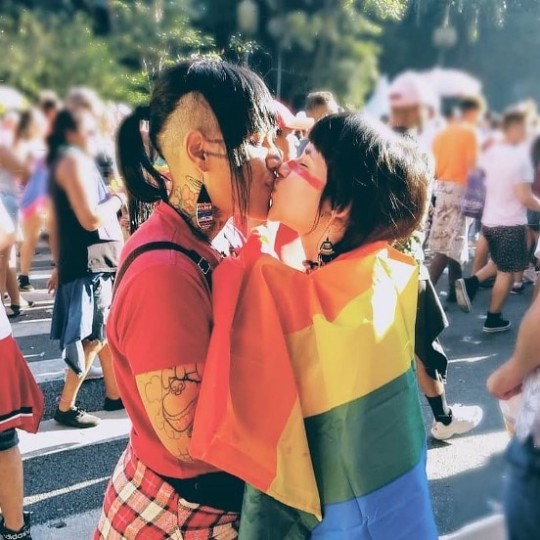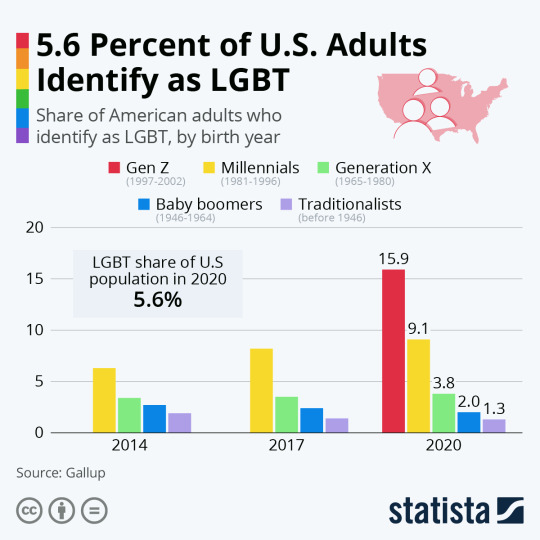Text
Group presentation on the film Welfare by Frederick Wiseman
Info about the film: Welfare (1975)
by Frederick Wiseman
In his documentary “Welfare”(1975) Frederick Wiseman captures the activity and atmosphere in a Welfare center in 1970’s New york. His point of view is as unbiased as possible, showing on one side the claimers and on the other the social workers and welfare employees. In his own words, “All aspects of documentary filmmaking involve choice and are therefore manipulative. But the ethical ... aspect of it is that you have to ... try to make [a film that] is true to the spirit of your sense of what was going on. ... My view is that these films are biased, prejudiced, condensed, compressed but fair. I think what I do is make movies that are not accurate in any objective sense, but accurate in the sense that I think they're a fair account of the experience I've had in making the movie.” (potnitz, Frank (May 1991). "Dialogue on film". American Film. 16 (5): 16–21.)
Wiseman’s documentary is structured very loosely, he simply set up his camera and films for days on end, focusing on scenes like the plaidants in interviews with the social workers, or the workers discussing amongst themselves, and occasionally shows clips of the people in the waiting room, the janitor. Whether he had done previous research before is unknown, but one of his goals across his different documentaries is documenting the workings of American institutions and the people who are involved in them.
The documentary shows clearly how varied the cases that are brought up to welfare can be, and the different people who enter the center desperately seeking help. Many of the benefit seekers are european immigrants, young single mothers, men and women of colour and marginalised communities.
The documentary also shows the conflict between the simple act of charity, providing a person money for shelter, food and the convoluted bureaucracy they have to navigate, where even the social workers are confused and have to constantly ask each other for advice. The lack of communication between the different departments is also made apparent, several plaidant explain they have been referred back and forth between departments, in a never ending cycle, and that even when they are able to provide the paperwork they are still not guaranteed any help. Even the language barrier can be a big problem sometimes, when immigrants who speak little to no english have to plead their case and deal with the different papers and statements they are asked to bring.
This shows the stark contrast between the human tragedies and the mechanical, unyielding system, the conversations are repetitive and the claimants and workers go over the same points over and over. The whole exchanges are painful to watch, especially when we learn about the dire situation the people find themselves, their pain and frustration at the system failing them (cheques that are never received by the recipient, fair court hearings taking up time that they do not have, the imminent threat of being evicted and the basics of human rights not being met).
But Wiseman, does not only focus on the claimants but also the workers, and shows that they are just as human as the people on the other side of the desk.
He shows that many workers try their best to help but are tied by the system, or the tense exchanges between desperate, angry plaidants and the overworked social workers.
The documentary also shows the blatant racism people of colour face in 1970’s, through a scene in the wellfare where an elderly white man start insulting a black man sitting beside him, and the situation escalates until police officers have to remove him from the building.
Different important scenes:
A native american man talks about rejected by every organization he has gone too, he talk about the concentration camps his people have been put into and
the fact he has escaped.
“Everywhere i go they say “you’re Indian? Get out of here!’.”
A young man and woman, both married but separated from their spouses. The woman is epileptic and can’t work.
Their smile of relief when they are offered a room is one of the rare moments of happiness in this documentary. (it would have been interesting to see the accommodation the people are given)
A recovered drug addict who got himself work, an apartment and a dog, then lost everything but the dog, is told he can have a room in a hostel. He objects that he can't take his dog there. But the official says: "We're giving assistance to you, not your dog."
German immigrant who says he still believes that America is “a good country” , that wants to help people, but under under the circumstances he is considering suicide."I'd better look for a nice place to hang myself."
A young black woman is driven to tears, her interview lasts for hours with the conversation going back and forth about papers, authorizations and contradicting bureaucracy and rules.
Welfare social workers discussing how they can help the plaidants, and how to sort out the paperwork. It becomes clear that even the workers are confused by the numerous convoluted legislations, and the paperwork the plaidants are supposed to bring.
In the video, it can be seen that the artist wanted to focus on what the minority in the USA goes through every day, the problems that they have to face because of the environment they were raised in or brought to throughout their lives. The film is made in the 70s in New York, a city that is known for being a gigantic melting pot filled with people from different backgrounds.
The United States is a country that revolves around making money off of people instead of actually caring about them and their health and condition. That can obviously be seen in that film, when for example one of the people in it mentions that he hasn't eaten in 3 days because of the small amount of money that he has been given. He also mentions that he obviously can’t go around stealing food because that will lead him to get arrested, which just shows that those people are such in bad situations that they even consider stealing food to feed themselves and their families as they dont have another option, the government isn't providing them what they need and that is a very serious issue.
A problem that a lot of Europeans complain about in America when mentioning it is the lack of health insurance. There are many people who don't get any of their basic health needs because they just can't afford it. It gets to the point where people just deal with broken arms, legs, etc by themselves because paying for a simple appointment would be too expensive. The country has many problems when dealing with minorities and this film shows what those people go through by using a technique of recording them in a position where it seems as if they are trapped/with no way out. This also affects the person who is watching the documentary as it gives them a sensation of anxiety but also bringing a sense of naturality to it, as if the one who watches it is in their position dealing with the problems with them.
Throughout the documentary there appears to be an endless cycle of clients (from all walks of life) seeking financial help, but getting no quick resolve as they are having to explain and give proof on their situations over and over again; and to different departments. This suggests there is a lack of communication and/or understanding of the states rules and laws within the worker’s company. Evidently I am led to believe the blame for this confusion and lack of help for those financially struggling is on the USA government rather than both the parties shown in the documentary because the system is more concerned with making money FROM the people rather than making money FOR the people. Another reason I believe the workers aren’t to blame is because despite the chaos and some prejudice, they do all listen and attempt to help the clients that come to them, even if it was poorly. With more education and organisation within the company I do think many of the issues would have been resolved.
Welfare is a 3 hour long in depth look at the American welfare system. The film was shot in the Waverly Welfare Center in lower Manhattan where Wiseman documented the conversations and interactions that took place between citizens of New York and social workers (supposedly) helping them.
Wiseman’s method of filming in the majority of his films is to simply set up a camera for days on end and try to capture as much information as possible, this helped him somewhat in keeping his films unbiased but in his own words; film making involves choice and is therefore manipulative. As such films cannot be unbiased.
Wiseman’s ability is evident when we consider how he had to slough through days of film in order to make a film about bureaucracy entertaining at all times. Some conversations in this film feel so exaggerated or surreal that you can’t help but wonder if the individuals being filmed even knew there was a camera on them, but it being 1970 there is no way they couldn’t have noticed so they knew they were being filmed but either just did not care or thought they were totally justified.
At many times the social workers were portrayed as patient and helpful though we find ourselves sometimes rooting for the client even at times where they aren’t necessarily in the right out if sheer empathy for their situation in being bounced back and forth places and told different things, getting nowhere in the process.
An example of both a surreal and empathetic situation occurs around 2 hours and 40 minutes in where a man is trying desperately to get his social security check having being led to the welfare department from the social security department and is subsequently told to go back to the social security department.
He goes into explaining how he “rips off” different retailers and individuals to get by currently such as stealing chocolate bars from woolworths so he can eat or through ripping off people with car scams. Despite his questionable morality I cannot help but feel empathetic for him even through his ranting, nonsensical stories about mind control, psychic research and coincidental references to Godot.
I find it funny how a film shot in black and white portrays it’s subject matter in such a grey manner. Whilst the welfare system in America is portrayed as flawed and needing reform, wiseman shows neither the staff nor the clients as totally in the right or the wrong. There are situations where both sides are in the wrong and he seems to have balanced it out between the two.
1 note
·
View note
Text
Interviewing Emma Quick on Taxidermy
Have you ever been interviewed?
Erm, yeah actually few times now for some bands that I used to play (guitar and bass) in and also for a taxidermy magazine... that doesn't make this any easier though. I definitely prefer the role of the interviewer, although this is my first time doing that!
Have you ever given an interview before?
What/Who got you into Taxidermy?
Well I have to say that my magic 8 ball never saw this ever being something that I would do as a job once 'grown-up' but like mosty people who get into it, I've always been fasinated by Taxidermy since I was a kid. I think that interest stems back to a local Bradford museum that my mum used to take me to when little, which had a big glass display full of all sorts of native animals. That question of 'how did they get in there' really stayed with me. I didn't have a clue! I had been working a pretty serious and well paid corporate job up until about 5 years ago but thanks to an major extitenial crisis, I deciced to leave the industry, go travelling (again) and try and find a more creative path for myself once back. I booked myself in for a taxidermy day course thinking it would be nothing more than a small distraction and an opportuinity to learn but I got on so well with the two women running the course that they asked me to come back and be a part time apprentice for them. Everything just sort of took off from there.
What are your family’s/friends opinions on Taxidermy?
My family are all very supportive as are my friends but I did have a few people asking me when I would get a 'proper job' again during the first couple of years. People views on taxidermy can be quite polarised and the problem with that can be that people just don't know enough about the process or how things are procured. The main difference between a friend and an angry finger-pointing stranger is usual just that they are more comfortable to ask questions and find out more. Believe me, I had a steep learning curve there myself and a lot of moral questions around it but realising it's no longer just all men out shooting for throphies and now largerly a female based craft using only natural death and bi-products makes a big difference, for a start.
How do you think Taxidermy changes the world, what idea would you like to bring when you do it?
I don't think I would say it changes the world now but I think it's fair to say it did. I have very strong feeling against early traditional taxidermy as the animals were nearly always hunted and killed for purpose which just makes me so sad and angry but I guess I can see some ductional value in what the Victorians were trying to do in term of documenting natural history.
What are the good and bad things about Taxidermy?
The good is taking something that would usually be throw in the bin, incinerated or just rot away and making it into something that someone will love for years to come. The bad is the awful history of early taxidermy and the few people who still see it as ok to hunt in order to mount their animals (I'm looking at you, America).
What is your opinion on people who hunt animals with the purpose of Taxidermy?
Oh my god, well if you can't tell already... these people absolutely disgust me. Thankfully it very rare that I come into contact with them. My biggest consideration around what I work on is around trusted supply - nearly everything I use comes from registered conversationalist, animal sanctuaries and vets, and the rest is either found or brought in by my cats/friend's cats. I was very careful to seek out and interogate any contacts I was put in touch to ensure any animal I work on is from unavoidable death. I don't pay anyone for animals, only the postage costs so I can be sure there are no gains to be made from their death. This doesn't stop the odd person offering me something for money that I can feel in my bones has been killed, or the odd yank making some comment on my instagram thinking i'm down with hunting too. Blocked!
How do you think Taxidermy impacts the way people see animals?
I'm not sure about that but it definitely did make me see animals, and even humans in quite a new light. Learning about anatomy first-hand was so interesting to me and you really do start to look and see bodies differently once you get into that. We all seem a little more fragile now than we did before.
How do people's opinions on Taxidermy affect you?
Hmm, this is a tricky one for me. I'm naturally very sensitive and empathic by nature so I don't like to see anyone upset by what I do. I also totally understand that without delving into the subject and learning about the more modern side of the craft, that I expected most people to have some issues with it. I've had a few people contact me through my shop to tell me how evil I am and that i'll burn in hell etc etc (also, usually American) but I never retaliate with negativity. On the few occasions this has happened I have taken the time to write back and explain a little about how I obtain my animals and to my surprise, nearly all of them came back later to thank me for 'opening their eyes' and explaining. A couple even offered to buy something after! You can't write this stuff! I'd much rather people fire questions at me than get angry because they don't understand how it's all done or what my ethics are.
What, in your opinion, makes a good Taxidermist?
Someone who sincerely cares about animal protection and conversation.
What is your own opinion on people who stuff their own animals?
Have you ever had a bad experience with Taxidermying an animal?
Well I get them in all sorts of states, sometimes in terrible conditions. ie: Nearly every fox i've ever received has been hit by a car (bloody humans again!) or too far gone re decay. I never really get over the feeling of sadness if something is too rotten to work on but on the otherhand, i've managed to restore so many animals to their former glory that it sort of makes up for it, it's such an amazing and emotional feeling to bring something 'back'.
Do you feel a certain weight/responsibility when Taxidermying?
Always. Everytime I receive and work on something. This is the most important part of taxidermy for me. It also matters who my customers are and if they share the same ethical beliefs. I've found that nearly all of them do too.
How does the pandemic affect you as a Taxidermist? #
Yeah, it's been a struggle as most of what I receive is found so less people walking, less supply. I've really noticed an increase in people trying it out over this past year though - i guess the pandemic has been a good time for hobbiests.
Is there something that you would like people to know about Taxidermy?
I guess what I didn't realise is how much emotional attachment people make to the finished pieces. If i'm having a bad day I might take a look at some of my reviews as customers really do gush over what i've sent out and am bowled over about how much love there is for them. I often get people's life stories when working commisions and found that people don't see them as just a dead animal. They can hold all sorts of emtional ties to lost pets and lost loved ones and other such things. I'm often asked to make memorial pieces, or something that marks a certain stage in their lives. I couldn't have continued doing this if i just thought they were seen a a cool 'prop' for the mantlepiece.
Also, that it's really not as bloody, smelly or dirty as you might think (if you are any good, that is).
What are some stereotypes about Taxidermy that upset you?
Ha, there is no such thing as a positive taxidermy sterotype in film and tv tropes. We are always the murderers and phsycos! God i could list off a hundred films which include a sinsiter blood-splattered taxidermist with evil intent, and i'm sure some do exist but in real life, try and get to know us and you'll generally find good-hearted people. I won't say this upsets me because again, I understand how the craft is perceived and plus, I have a pretty dark sense of humour so it's easy enough to laugh this kind of thing off.
Have you always been interested in animals?
Yeah I've been a real nature girl ever since I can remember, certainly my first and last love. I'm definitely one of those weirdos who prefers animals to people and have had loads of different pets around the home throughout my childhood - Dogs (dog i love dogs!), cats, mice, gerbils, rabbits, ferrets and snakes to name just a few. My sister and I were brought up to love and care for creatures as much as my mum does - she is bascially like Ms Doo-little, taking in strays and injured animals and making sure they find homes and the treatment they need. It made me chuckle to myself reading Lorena's answers as very simiarly, me and my sis were young members of all sorts of wildlife groups when we were little and were always reading some sort of wildlife encycolpedia or heading off to the woods while our mates were more interested in mum's lipstick etc.
Was it hard for you to be interested in such a different form of art when it comes to finding materials to use?
Are there any Tv shows/artists/documentaries, etc that you recommend people watch to learn more about Taxidermy?
Erm, yeah this can be hard given how we taxidermist are perceived but I am starting to see a few documentaries pop up about modern day practices which is a welcomed change. I remember the bad film portrayals better than the few doc but i think even Netflix has one film called 'Stuffed' on it currently which does help provide a more realitic view of the craft.
Why do you think a lot of people see Taxidermy in a negative way?
What would you tell someone if they want to start practising Taxidermy?
That there is so much to learn and you'll never really stop learning. It's a difficult thing to do right and does take years of practice. I've spoken to people who have done it for over 30 years who still consider themselves as ameatures. My main tip would be to ensure your supply is a clean one and you are not adding any more unneccessary pain to the world.
What is something you would like to tell people about Taxidermy (a random fact or just a curiosity)
I once read that taxidermy started because of the Platypus. The explorers who found it did not believe it was a real animal and that someone had artifically created it so they disected one and sent it back to scientists to validate the strange (and very lovely little) creature, or so the story goes....
Please add here any additional information or commentaries that you find that are interesting to people who aren’t very familiar with Taxidermy.
1 note
·
View note
Text
Have you ever been interviewed before?
No, I have never been interviewed before.
Have you ever given an interview before?
No, I have never
How would you describe yourself in 5 words?
Hard-working, extroverted, passionate, perfectionist and opinionated
How has your year been and how has studying through a pandemic effected you / your family & friends / your artwork?
My year has been going pretty bad, I have been seeing myself going down when it comes to the effort I put into the work I do. It has been hard to deal with my mental health but hanging out with my family and taking care of my puppy has been helping a little bit. I actually think that I feel more comfortable working from home. As much as I adore spending time with people, I can’t get myself to focus on my work while I am on campus.
Any particular highlights / low points?
I would have to say in February when I had to move out of England all by myself, it was quite hard having to sell all of my stuff in less than 2 weeks while also having to study.
Who or what inspired you to stop eating meat (sorry, the most boring question no 1)?
I have always had a passion for taking care of animals. Since I was a child you could find me watching National geographic documentaries which wasn’t something that could be considered normal by my peers that were more interested in makeup and barbies.
I used to read a few articles by GreenPeace as I was subscribed to receiving their emails. And that was probably what opened my mind. I went to the kitchen to vent about how humans treat animals very badly when my mom said ‘If you like them so much why do you eat them?’ and I think that woke something on me. I then started rethinking my actions and reading more about veganism and how my eating decisions affected the world around me.
What’s the hardest part / thing to give up (sorry, the most boring question no 2!)?
Being raised by Brazilians, the worst thing you can do to disappoint your family is stop eating meat. Most Brazilian dishes have meat on them so it was quite hard for me to let go of it. However, I am a very determined person and I prefered to stop eating meat right away rather than go step by step. It was a bit hard on the first week but as soon as I would think about why I was doing that it would give me the strength never to eat meat again
Have you ever had moments where you have ‘slipped’. How have you felt when that has happened?
Yes for sure, every veg person has. I once had to eat a burger when I visited France. It got me so sad that I saw myself crying while eating it. It was a very sad experience but I was very hungry and had nothing to eat.
I was also in situations where someone got my order wrong and they would throw the food out so I chose to eat it. It's better to eat meat than waste food. It's how I always say, the world doesn't need 5 perfect vegans but rather many people trying to make a difference.
How do you feel about the use of animal bi-products?
I am against any use of animal products including by-products, however, if there is such a thing as a meat industry I agree that it is good that they use the entire animal rather than waste their lives and throw some parts out. I cant check every single product I consume if it has by products but I try my best to.
What would you say to someone that says vegetarianism/veganism is just another fad diet and it will disappear in a few years?
It is very obvious that veganism is growing in people every single year. I can’t count how many of my friends are veg because it is that common.
How do you feel about Gary and his family of nut-based vegans cheese? / alternative products such as sprinkle ‘It on everything’ bacon?
It is amazing that there are so many options nowadays for non-meat eaters, I’m sure it was very hard for veg people that are nowadays in their 50s as they did not have any replacements at the time. I sometimes crave meat and it makes me happy that i'm able to eat something similar to it without harming animals.
Any tips to help any junk food addicted meat eater who very much consciously wants to change to a more vegan / veggie diet but really struggles to make that first step?
I would advise them to try to eat vegan once a week, then the next one try eating twice and so on. It is completely fine to eat meat once a week because it already helps a lot, as I said before, it's fine to make mistakes. Besides, nowadays most fast food such as mcdonalds,burger king etc have vegan options so it's easier for people transitioning.
Are there any organisations or movements that you feel support the same ideals and outlook as you / are there any that you feel have a negative impact on winning people over?
How do your beliefs influence your art and research practices?
What’s your idea of happiness? I.e. If money was no object and therefore work and education didn’t matter, how would you like to spend your days?
What makes you unhappy?
Are you sick of these same old predictable questions? Is there anything you’d personally like to say about animal welfare and preservation that never gets asked?
I would just like to say that it is okay to make mistakes. We as humans make mistakes all the time but any effort is going to be rewarded to you in the future, i'm not talking about going to the sky or being judged by God but rather the satisfaction of going to bed every night knowing that you are at least trying to do something good, and there's nothing that makes me as happy as that.
1 note
·
View note
Text
IS BEING A PART OF THE LGBTQ+ COMMUNITY A TREND?
+Throughout the years’ many people are seen coming out as queer. And nowadays it is even more common to see queer characters in media as something that is becoming normalised. For example, in this early graph made by Gallup, (an American analytics and advisory company based in Washington, D.C.) we can see that the amount of people ‘coming out ‘ and identifying as a part of the LGBT community grows every year. Yet, it is seen to be more common in people who are born from 2002 to 1997, that being generation Z. After that, being Millenials, who are followed by generation X. Besides that, it can be seen that few traditionalists identify as LGBT, for a reason that I will be talking about in this essay.
We can also see in the graft that those numbers rise throughout the years. And why does this happen? Is it because Millennials and Gen Z started a new trend of being queer? Or is it because they feel more comfortable talking about issues that used to be hidden before.
Queer representation has indeed been growing a lot, if not in movies or magazines, Kids nowadays can spot a drag queen only looking through social media, or even Netflix, a Movie platform that has been seen adding a lot of queer characters to their movies and shows. If Netflix is doing a good job at bringing awareness and representation that is another conversation but compared to 10 years ago, it is noticeable that every day queer representation grows more and more.
Yet, the only place we can see this is in media, as there is not much of it in the regular history classes we have at school.
It is also important to note that kids can be very moldable. They spend more than 11 years of their life copying exactly everything they see, that being something positive or not. And that happens so often, that a boy died in Indonesia after trying to copy the fictional superhero Spider-Man. ‘Police are investigating if a five-year-old boy in Jakarta was trying to mimic Spider-Man after he jumped out a window to his death after being told he couldn’t watch the latest movie in the franchise.’. And as surprising as this can be, it shows kids and teenagers can be influenced by something so much, they will try to mimic it, which might be happening to all the Gen Z adults who grew up with media shoving down LGBT content down their throats. As well as that, they can also be following their friend’s choices to come out and can be even lying to their own selves for attention.
I could spend an enormous amount of time writing about how social media can affect peoples sexuality and gender but I’d rather do something more educating and look at the past. Where humans started coming together as tribes and living in a society, having to deal with the presence of each other and create romantic and social relationships.
When talking about same-gender relationships the queer community mentions how normal gay relationships are in nature. Petter Boeckman, Norweigan Zoologist would say that more than 1500 species of animals have been seen having some type of homosexual interaction, those not only being mammals but as Boeckman stated "We're talking about everything from mammals to crabs and worms. The actual number is of course much higher. Among some animals homosexual behaviour is rare, some having sex with the same gender only a part of their life, while other animals, such as the dwarf chimpanzee, homosexuality is practised throughout their lives." as well as that, he then compares chimpanzees to humans who identify as homosexual "If a female has sex with a male one time, but thousands of times with another female, is she bisexual or homosexual? This is the same way to have children is not unknown among homosexual people.". However, Petter wasn’t the only one who found homosexual interactions between animals, Kurt Kotrschal, a known biologist for researching these types of behaviours has confirmed that these ty
pes of relationships are beneficial for the species.
I am mentioning animals not only to show that homosexuality is natural to other species but because they can be even more related to indigenous people.
Indigenous people are the ones who can be seen the most in contact with nature. They have decades of history of not having any contact with other human beings than the ones that were located in the same tribe as them, and as much as they would fight with other tribes and move around they still had their tribes, where they would create relationships in and settle their tents. They didn’t have any contact with books and science before the colonizers came in 1500 and even after that many tribes weren’t discovered by them in the middle of the Amazon forest, so many of them didn’t even get to be influenced by the Europeans and their racism and misogynistic views and homophobic religion.
The point I want to make is that indigenous people are the ones who are the closest to animals, and if they saw an animal do a homosexual interaction, they would probably see it as something that is intended to happen and not weird, as animals don’t have a perception of that is morally wrong or not. They are a part of nature, different from the Europeans who colonized them who were already influenced by the church and their extremist ideas. And as much as it would be wonderful to have indigenous people be so open-minded as they were, Colonization happened, and with that, so did a period where Europeans found the need to force their catholic beliefs on them, as well as bringing many diseases and suffering. Cieza de Leon, a chronicler of the conquest in Peru once said, and I quote ‘ Within a somewhat different framework. During the colonial years, indigenous morality changed, partly as a result of contact with the Europeans.’She also believes and argues that indigenous people had a spiritual justification for doing anal sex with their partners ( which is now seen as something Queer people are more familiar with), that being in a same-sex or straight relationship. This spiritual justification had to do with their religious beliefs. While Colonial Latin American societies would see anal sex within their own beliefs, Iberian societies would see sodomy as a way of showing male dominance.
There are not that many pieces of evidence of Queer indigenous people in history, as the colonizers would murder them and force them to stop being who they truly were. However, there’s an engraving that shows a little bit more about their experience as trans indigenous people in colonial times. In this engraving made by Theodor de Bry in 1594 as part of his Les Grands Voyages, we can see how this homophobia is well represented. In the art piece, 8 men are shown wearing noble clothes, and between them was Vasco Nunez de Balboa, a man known for being a Spanish nobleman who conquered Panama. But what is atrocious about this art piece is what is in front of them, 3 men being eaten alive by dogs after being demanded to do so by the nobleman, after being seen dressed as women. However, what is most ironic about this engraving is the way it’s presented, which plays when seeing the men standing above them. Who present themselves in a feminine way earring clothes that could nowadays be considered quite puffy and girly. This engraving is only the beginning of what queer indigenous people had to go through, of course not mentioning the amount of evidence of homophobia that was probably erased through the time. To summarize Brazil’s colonization process, the European view on lust, nudity, polygamy, cannibalism, sodomy and homosexuality which was normal to indigenous people, was considered to be against nature and gods will, and their job was to basically baptise as many natives as they wanted and shove catholic ideas down their throat.
Yves d’Evreux, a french capuchin priest delivered a highly dramatic letter, that presented his reaction on how he encountered an indigenous that could be considered a trans man. His trip to Northern Brasil (1613-1614) surprised him , as he reacted in a negative way towards them. As he wrote ‘There is, in Juniparan, in the Island, a hermaphrodite, in the exterior more man than a woman, since he has the face and the voice of woman, with fine, flexible and long hair, however [he] was married and had children (...). (d’Evreux, 1874, p. 90) he then mentions this man again, as he ran after him with the French to ‘purify his soul’ and kill him, he was then captured and chained under the fort of Sao Luis and was obliged to say the following ‘You will die for your crimes, we approve your death and I myself want to light the fuse for the Frenchmen to know and to see that we hate your evil deeds [...]: when Tupan sends someone to take your body, if you want to have in the Heaven the long hair and the body of a woman instead of that of a man, ask Tupan to give you the woman’s body and to be resurrected woman, and you will be in Heaven on the side of women and not of men. (d’Evreux, 1874, p. 232). This however is just a glimpse of what transgender people had to go through during colonial times and still to this day. The queer community is a community that is supposed to help everyone, but that doesn’t focus much on the history of indigenous people and how much they suffered.
In conclusion, as much as nowadays, people can be highly influenced by others, the LGBTQ community has been around for a rather long time and it is not something that the newest generation has made up. From the colonization times till nowadays, queer people have felt oppressed and the necessity to ‘stay in the closet’ and not be their true selves while being afraid of getting judged or even murdered by random people or even close ones. However, nowadays people have been talking more about important issues such as homophobia, sexism and racism, which is making queer people feel more comfortable Even though, they are still fighting for their rights, and they’re still in the long run, protesting for all the people who have died since Europeans somehow decided that god found their sexual choices to be unnatural and demoniac. Now, what is left for us to do is to create a healthy environment and show more representation in media every single day, so more queer people feel comfortable without having to spend their entire lives fighting and running away from who they are. Being queer is not a trend, but queer people have been being hidden from us our entire lives. They were always there, and they are always going to be there.
Bibliography:
Partal, Y., 2021. Are there gay animals in nature? Homosexuality in the animal world. [online] Zoo Portraits. Available at: <https://www.zooportraits.com/animal-homosexuality/> [Accessed 5 April 2021].
Sigal, P., 2003. Infamous desire. Chicago: The University of Chicago Press, p.2.
Fernandes, E. and Arisi, B., 2017. Gay Indians in Brazil. 1st ed. Springer.
News-Medical.net. 2021. 1,500 animal species practice homosexuality. [online] Available at: <https://www.news-medical.net/news/2006/10/23/1500-animal-species-practice-homosexuality.aspx> [Accessed 9 April 2021].
New York Post. 2021. 5-year-old boy dies ‘trying to be Spider-Man’. [online] Available at: <https://nypost.com/2014/05/04/5-year-old-boy-dies-trying-to-be-spider-man/> [Accessed 9 April 2021].
Jackson, A., Thomas, M. and Steffen, A., 2021. Homosexuality Is Natural. [online] Exposing The Truth. Available at: <https://www.exposingtruth.com/homosexuality-is-natural/> [Accessed 9 April 2021].
Buchholz, K., 2021. Infographic: 5.6 Percent of U.S. Adults Identify as LGBT. [online] Statista Infographics. Available at: <https://www.statista.com/chart/18228/share-of-americans-identifying-as-lgbt/> [Accessed 9 April 2021].
Pictures:
1475. Spanish Explorer Ordering Native Indians To Be Torn Pieces By Dogs Copper Engraving 16Th Century. [image] Available at: <http://www.latinamericanstudies.org/debry-atrocities.htm> [Accessed 9 April 2021].
n.d. Two indigenous women kissing at an LGBTQ+ pride parade. [image] Available at: <http://@indigenasLGBTQ> [Accessed 9 April 2021].
n.d. Trans (We’wha (Zuni) circa 1849-1896 Mexican Indigenous woman. [image].
3 notes
·
View notes
Text
Ellen Von Unwerh, the feminist photographer
This first picture is quite strong in my opinion. In it three women can be seen eating peaches while sitting next to each other in a certain position that isn’t necessarily pleasant to the eyes of a sexist society. Ellen Von Unwerth is a German photographer born in 1954. She is most known for her amazing shots of strong powerful women in sexy as well as aggressive situations. Besides that, this picture shows exactly what Ellens work is all about. As women are expected to “behave” and sit in a straight position with their legs crossed, straight back and neck and looking forward. It is soothing to see such an incredible shot of women just being themselves without a filter and going against the so called “manners”. As it can be seen, their legs are wide open, showing much cleavage as they comfortably eat a peach with their bare hands, without worrying if they would get messy or not. And as Ellen even said, “I don’t want to objectify women, or cast them only in this ‘sexy’ light. I want to see every side of them. There are so many sides to women. That’s why some of my best shots come when the girls think the camera has stopped rolling, you’re seeing something different to what they give you when they know they’re being watched, a vulnerability.” and it is that vulnerability that she mentions that can be clearly seen in this shot. The models can also be seen wearing “childish” clothes, which implies that they are acting like when they were kids and didn’t have to care about body standards or what society would say if they did this or that, they just want to enjoy their peach on a sunny day.
The second picture also speaks for itself in a way that it is a strong piece. In it we can see a naked lady reading a journal while getting breakfast sitting at the table. This image already has a sexiness of its own. It brings the idea that her body is being covered by only two pieces of paper, which are filled with mysteries and news. However, reading the newspaper has been a sign of masculinity even nowadays. The wife is expected to make breakfast while the man of the house reads his newspaper sitting on a chair while smoking a cigarette inside after being told not to multiple times by his lovable wife. Which he chooses to ignore as her opinion doesn't matter in a sexist society. However, this picture shows the opposite. As we can see she is placed in an environment where it is not her duty to make food for anyone. And she was probably caught in a very vulnerable state, where a normal woman drinks her morning tea while reading the newspaper. This was already a picture by Ellen that brought the idea of something known for being masculine being done by a feminine person.
As we could see some masculine representation on the last picture, this piece now takes it even more extreme and brings fashion to make a point. In the picture, a woman can be seen wearing a suit while holding a rose. Her eyes are quite darkened by a big amount of black eyeshadow and her expression brings the impression that she is the boss. The background filled with feminine and delicate furniture really contrasts with the masculine energy that the model brings to the picture. I would like to bring the idea of Image Spam by Steyerl Hito on the text ‘The Wretched of the Screen’, “Image spam is thus interpreted as a tool for the production of bodies, and ultimately ends up creating a culture stretched between bulimia, steroid overdose, and personal bankruptcy” So this ends up showing the importance of Ellens work, as Steyerl wrote “images trigger mimetic desires and make people want to become like the products represented in them”, Ellen shows a reality where women can be whoever they would like to be and still look sexy, as I quote “I’ve always loved to portray women who are strong, who are playful, who are self-assured, and who really own their sexuality, which is why I love working with Claudia, and Naomi, and all those girls.”
The last picture brings a certain time of certainty. A very well put woman walking her two maltese dogs goes shopping, hoping to spend all of her independently made money on clothes that will make her look even more like a goddess. And while she does it, also uses a servant that works at the expensive hotel she is currently staying in to hold all of her shopping bags. This image brings a lot of empowerment and the idea that it is a powerful move to look sexy and well presented at all times. She also brings the idea that she owes the world and is above all, and that was only achieved by her looks and confidence. Something that is very important to be represented in the media. As I quote Steryel “From the perspective of image spam, people are improvable, or, as He put it, perfectible. They are imagined to be potentially “flawless,” and that's what this series of images shows. How it is normal to open your legs and do whatever you want mainly as a woman. If we are shown to be weak, show them otherwise, which is what Elle was reyung to perceive as a photographer, in which she obviously succeeded.
Bibliography
Operagallery.com. 2021. Ellen Von Unwerth. [online] Available at: <https://www.operagallery.com/ellen-von-unwerth-viewing-room> [Accessed 12 March 2021].
2013. Hito Steyerl. The wretched of the screen. New York: Sternberg Press.
Bmw.com. 2021. Creative Leader Ellen von Unwerth: Freedom from every perspective | BMW.com. [online] Available at: <https://www.bmw.com/en/automotive-life/creative-leaders-ellen-von-unwerth-interview.html> [Accessed 12 March 2021].
Unwerth, E., 2002. Peaches, Rouilly-le-Bas. [image].
Unwerth, E., 2004. Elle MacPherson. [image].
Unwerth, E., 2010. Elisa Sednaqui. [image].
Vogue, 2004. Bianca Balti for Vogue Italy. [image].
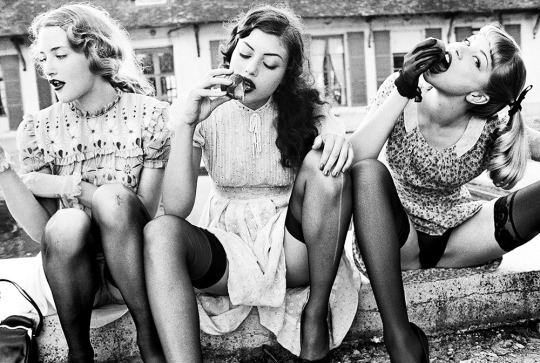
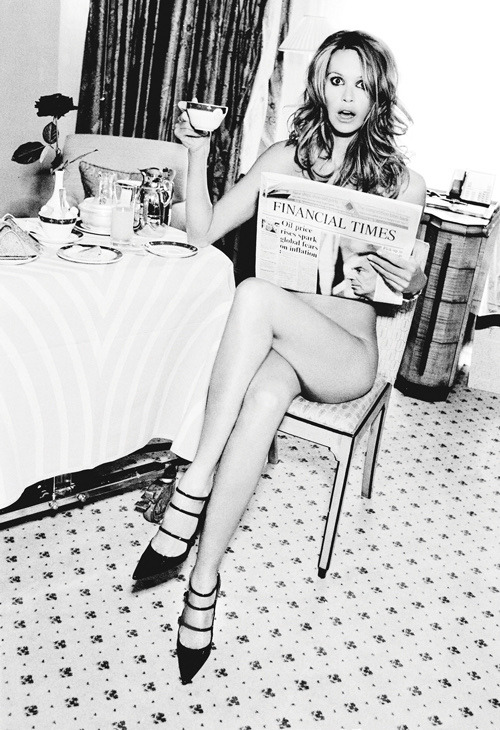
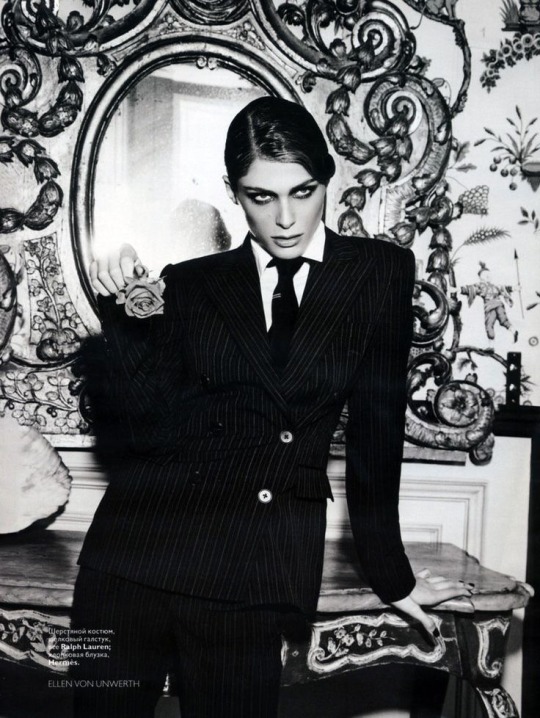

0 notes
Text
Something that amazes me about photography is the way that it can be used in a professional manner as to even getting to the point of being able to save someone's life! As stated in the text, and I quote "Photographs furnish evidence" for a long time people have been using photography to prove a point, but not only that, it has actually been used to show evidence of something that happened, like something as simple as proving someone that something happened that they might not believe in, but that it can be easily proven with a single picture. However in this paragraph it is shown that photography is even more important that we think it is. "A photograph passes for incontrovertible proof that a given thing happened" as it is used in criminal cases to show that a certain thing took place. As well as it can explain why that certain thing happened, how and where. A single photograph can show so much information and that just confirms how important photography actually is!
However, we might be fooled by pictures and things can even look like a certain way which in reality they are not. As written "The picture may distort; but there is always a presumption that something exists, or did exist [...]", as much as a single picture can give out lots of information it can also bring lots of uncertainties. Sometimes things don't look the way they're supposed to and what seems like something might just not be it. As a picture is only a millisecond of something that happened, sometimes things can get tricky, and it is up to us to analyse it as much as we can so we don't end up getting tricked. Every picture has a story which should be explained not to create false information.
One of the first real crime scene pictures. Madame Debeinche dead on the floor in 1903.
All That's Interesting. 2021. 28 Serial Killer Crime Scene Photos That Capture Their Murders In Chilling Detail. [online] Available at: <https://allthatsinteresting.com/serial-killer-crime-scene-photos> [Accessed 19 February 2021].
Sontag, S., 1997. On photography. 1st ed. London: Penguin books.
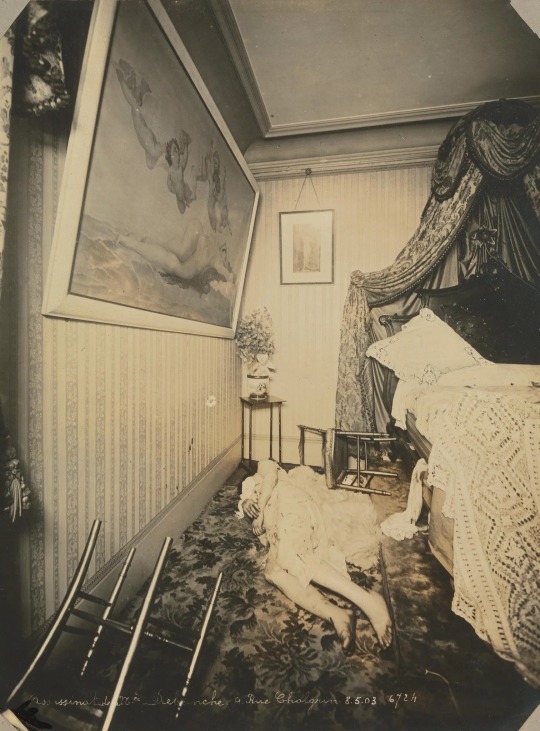
0 notes
Text
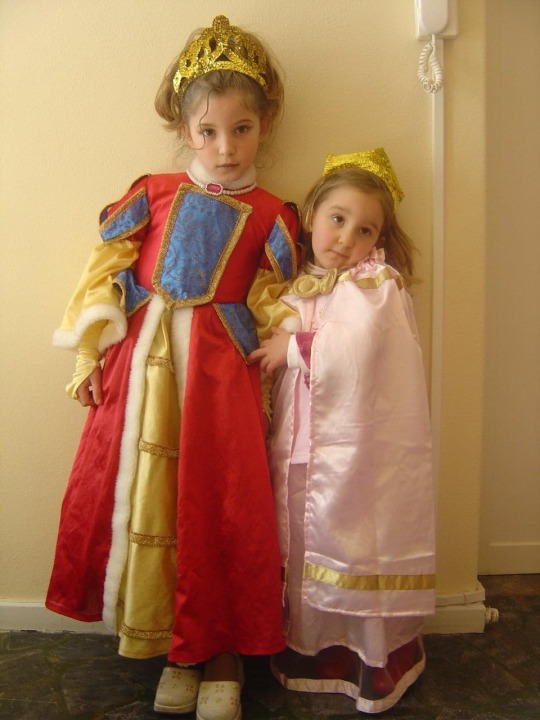
This picture was taken by my mom in Portugal during carnival, my sister and I were dressed by my mom in princess and queen costumes as we obviously adored the idea. As a kid, I used to love dressing up and taking photoshoots as I was overly confident. This picture brings me lots of happiness and nostalgia.
0 notes
Text
HAIRY SITUATION
Body hair - should we care?
WARNING!
This manifesto is a non-manifesto.
It is not a preach for change.
It is not calling out an existing norm and forcing a new tradition.
What is this then?
It is a set of equations that can help simplify YOUR decision-making to support INDIVIDUALITY and PREFERENCE.
This non-manifesto can be boiled down to 4 simple equations.
If you:
have body hair + love it = do what you want
have body hair + hate it = do what you want
don’t have body hair + love it = do what you want
don’t have body hair + hate it = do what you want
Minding your own business:
Body hair is still associated with topics it should not be associated with.
politics
gender
Mixing OPINION and FACT is a tricky business as there is a chance of imposing opinion AS fact.
OPINION ≠ FACT
The blurred lines between OPINION and FACT leads to people following other people’s opinions as facts and that leads to following opinions you don’t agree with. For instance:
Shaving your legs when you don’t want to
Not wearing certain clothing to hide body hair
Wasting money on razors and waxing when you don’t want to
Time spent when one could be doing more enjoyable or productive things
Environmentally impacting the Earth by using disposal of razors.
(Did you know the average person who shaves daily or near-daily uses 40-50 disposable razors annually)
OPINION VERSUS FACT:
Believe it or not many individuals believe their opinion is in fact, fact.
This non-manifesto believes:
All opinions are valid
All facts are valid
Opinions are not facts
Facts are not opinion
“clean shaved woman means beautiful”
“a beardless man is not a man”
“hairy legs can’t be on display”
These are OPINIONS that are confused for FACTS.
Body hair is ART!
This manifesto exists to drive people to never conform to rituals that one does not like.
You are in control. You can make a statement. You decide how to present yourself to the world.
Your body hair is YOUR statement, it can be a weapon of self confidence, it’s taking ownership of your own body and refusing the preferences that someone else has set UPON you.
Just always be sure it's your choice and no one else’s.
Anonymous Anecdotes:
Anecdotal evidence suggests that promoting choice and following the previously mentioned equations leads to a healthier relationship with yourself.
#1Growing up in a latin household is getting used to sexist behaviours from all of your family members including your mom and sisters. From the age of 11 my parents and siblings have warned me that having any type of pubic hair was dirty. And nothing has changed to this day. As I go to the beach, I still feel the need to shave every single inch of my body. However, my brother always finds a way to judge the way I look, from finding a single hair on my armpit to squeezing my leg and commenting on how disgusting my cellulite is. This was obviously harmful to my mental health as I now never wear revealing clothing if I haven't shaved beforehand.
Issues here: shaving when she didn’t want to, opinions imposed as fact.
#2 For most of my childhood, I wasn't really aware of my appearance. I chose the clothes that I enjoyed wearing (a lot of long skirts and wellington boots) and I didn't think that my choices would matter to anyone else. This changed when I started middle school, through teasing and comments from friends and others peers. I remember vividly the first time I was told I should shave, I was around 13 years old. My first reaction was surprise that it was an issue for anyone, then acute embarrassment since it became apparent that having armpit hair was undesirable and something to be ashamed of. Years later, while I still shave my armpits, I regularly don’t bother doing it, and I never shave my legs. Not caring as much is definitely freeing.
Issues here: person knows of other people feeling unhappy with body hair. Toxic ideals AKA opinions imposed as fact.
#3 ‘Even though I think body hair is perfectly natural and I have nothing against it, I always notice when a woman (or even a man) has a lot of hair under their armpits and I think “they must get teased”. Then I remember that there is no reason why it should make a difference to their life, or the way I perceive them.”
Issues here: person subconsciously assumes negatively about body hair despite themselves being open and supportive towards it.
#4 A 14 year old found herself having to wear a bra inside her own place because her mother was jealous of the ‘attention’ she would take from her own dad.
The Art of Not Caring:
This non-manifesto supports not caring about what others think of you if you do not VALUE them.
This mentality is the biggest power you have over yourself.
This non-manifesto supports defending yourself when you need to and not defending yourself when you don’t need to.
Analysing people's OPINIONS TOWARDS YOU is empowerment.
BORN THIS WAY… and that way… and this way…
One is not born with a set notions of what one should look like.
Notions are learned and taught.
Some people are taught through IMPOSED OPINIONS a “proper way” to conduct oneself, body hair is part of that.
It should not be.
ENOUGH WAFFLE, WHY SHOULD I LISTEN TO YOU?
So you have reached the end, thank you and well done. But why should any of this be of any significance to you?
It doesn’t have to, but it can be.
You may disagree with everything you have just read. That is valid.
This non-manifesto believes all opinions are valid.
Even if you don’t agree with it, it agrees with you.
I’m not saying every woman shouldn’t shave. I just want women to make informed decisions and ask themselves why they do it. It’s about self-worth and love. I don’t want there to be women shaving because they think they’re disgusting if they don’t. The fact that we’re making decisions based on toxic ideals really saddens me.”
Referencing:
Leaf score, The place for green. The environmental impact of shaving products. July 3rd, 2020
https://www.leafscore.com/eco-friendly-bath-products/environmental-impact-of-shaving-products/

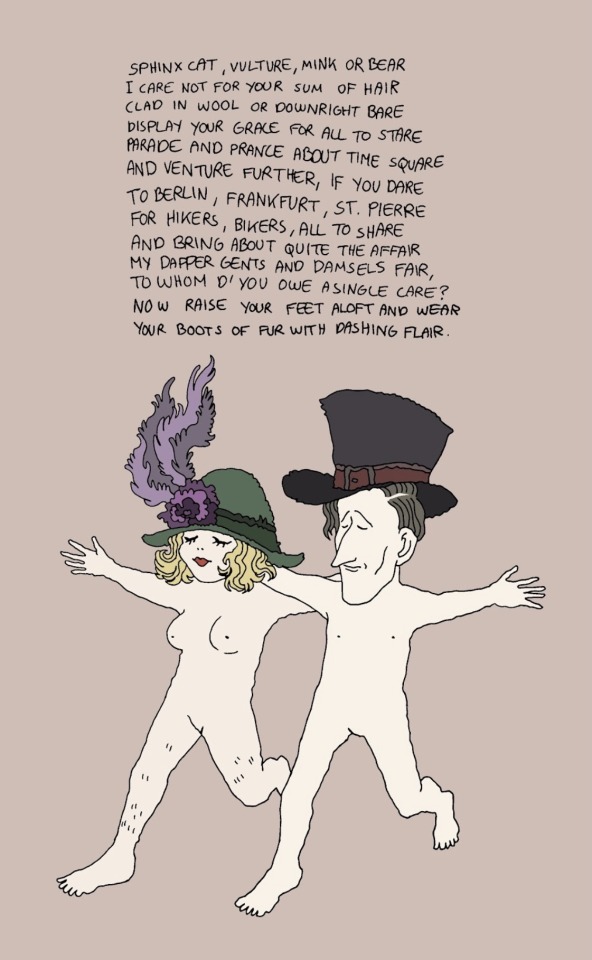
0 notes
Text
My experience with writing as a group
I can't say I enjoyed doing a group project where we all had to write a manifesto together. It took a rather long time for us to decide a topic to write about and when we did choose it, we didn't know exactly how to work with it. We started off by writing our own opinions and then putting them together as a whole, however, the group wasn't balanced enough in my opinion. Some people did too much work while others did little to nothing, and I don't blame either of them, it was a new experience and no one was really used to the idea of writing something as a whole.
Overall, Ive already accepted the fact that I don't really enjoy working as a group. I tend to get irritated because when working by myself I tend to do tasks right away after they are assigned, however, when working as a group, patience and time is needed, something that I'm not really known for having much of.
0 notes
Text
The Painting of Sounds, Noises and Smells (1913)
I have decided to look at the Chapter M12 Carlo Carra “The Painting of Sounds, Noises and Smells” (1913) because it caught my attention to know a little bit more about the Futurist art movement and what it was all about. I have learned about Impressionism during my foundation year and how the movement was all about putting down feelings and extreme emotions of sadness, happiness, fear, etc… However, in this paragraph, it is clear to anyone that comes across it that the Futurists saw themselves as superior compared to impressionists. As I quote “[...]Impressionists never succeeded in painting sounds, noises and smells”, as well as mocking the way that Impressionists “tried” to do what Futurists are so known to do, Carlo Carra makes sure to state the reasons why Impressionists are so bad related to them, and what they had to do to succeed like them, so-called futurist artists.
And in my opinion, the futurists were right. No matter how much I enjoy Impressionist art, I am certainly fond of the way that the Futurist movement changed the world of art. Their paintings not only show the audience colour and movement but life. While looking at an Impressionist piece might bring satisfaction due to the amount of colour and movement, Futurist art goes beyond anything plain. Looking at a Futurist painting feels like watching an action movie that anyone would want to dive into. And we can feel not only the emotion of a racing car but the breeze of a sea of watercolours and the citric smell of acrylic painted oranges.
Futurist art has its name for a reason. Considering that the 18th century was all about boring paintings with cold tones and pretty pictures of women and people of power, the Futurists came in with excitement and a feeling more described as fulfilling, that being only achieved with, and I quote “ the rrrrredest rrrrreds that shouuuuuut”.
Picture:
Ugo Giannattasio (1888-1958), untitled, 1920

0 notes
Photo

I decided to go on a walk today and reference once again Mona Hatoum’s work, and as well as that, I wanted to reference my first walk, and compare those two based on my skin colour and gender. As I wrote in my last text, the video Roadworks by Mona Hatoums is a video that criticizes the police and how racist they are against people of colour. I then decided to go on a walk to Golders Green. I started walking and each step I took I would ask myself how I was feeling about certain situations. I once again went with my friend, because as I said in the first text, as a woman, I don’t feel comfortable walking around by myself. That morning I decided to wear only clothes that would cover parts of my body known for being sexualized by men, and that did make me feel more comfortable walking around, but as someone who has been catcalled wearing that exact outfit, it was good to know that it didn’t really matter what I wore, I would always somehow get catcalled or overlooked at. However, before, I was paying attention to how I suffer as a woman, but instead, now it’s about how I don’t suffer as a privileged white person. After taking the walk I decided to sit down and go back at how my experience was, and I noticed how I didn’t see any police cars around the area. I then questioned myself if I didn’t see them or if I just wasn’t looking or minding them at all because they don’t really affect my life. I wasn’t doing anything wrong and I would only be able to notice them if one of them rode past if I were doing something illegal such as using drugs or stealing something. However, I am certain that is not how a person of colour sees the world. I have heard stories from black people who told me that they would give the drugs they were carrying to their white friends because they knew that the police would only search for them. And it is truly disgusting that anyone should fear the police because I have never! I want to live in a world where the police are seen as the one who is supposed to protect instead of bringing more sadness and anger to the world. They have killed multiple people with no explanation and I am curious to see more artists show the world this issue, just like Mona Hatoum’s did.
0 notes
Text
Roadworks by Mona Hatoum, 1985
Mona Hatoum (1952) is a Lebanese artist known for focusing on artwork that somehow critiques social issues such as domestic abuse, politics and equality. In the video Roadworks, she is being recorder walking with two platform boots tied to her ankles, as those symbolize cops. What got my attention is the fact that she is barefoot, since this video criticizes equality and how the police treats people of colour. By being barefoot, the viewer can empathize with her pain, as being barefoot on a sidewalk isn’t really something that is considered comfortable for most. Her naked feet represent people of colour, people who are constantly suffering and in an uncomfortable situation, they might step on glass and hurt themselves, so it basically shows that POC have to walk on the streets scared of steeping in the wrong place. They have to look out for the police at all times, as someone who is barefoot does to harmful things on the floor that might hurt them and give them a big wound, that wound that takes so long to heel and turns into a big scar, symbolizing how going to prison or being treated like garbage by police officers can bring pain, traumas and scars. Another thing that made me interested in this video is that her being tied to the boots that represent police officers, it means that people of colour can never rest. They are always being watched no matter what their age is, what they’re wearing and doing. They have a constant fear of getting judged and harmed by people who are supposed to help them and make them feel safe but do the opposite instead. The Black Lives Matter movement has been something that has opened my eyes, as a teenage girl. Growing up white and privileged, I ended up not paying much attention to such issues, since I have always studied in expensive schools, I didn’t get to have much contact with people of colour and what they have to go through every single day, and that is why Monas work is so important, it is important to show people issues that they might not think about, and open their eyes to those so important issues.
Reference:
https://www.li-ma.nl/lima/catalogue/art/mona-hatoum/roadworks/8990#
https://en.wikipedia.org/wiki/Mona_Hatoum

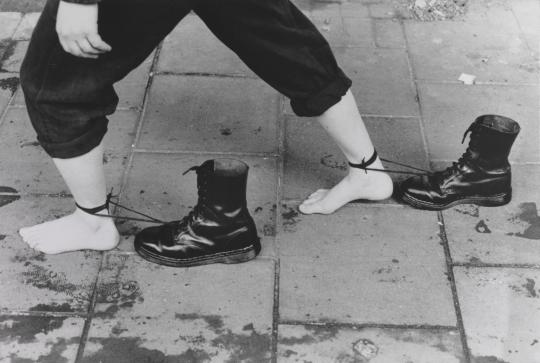
0 notes
Photo

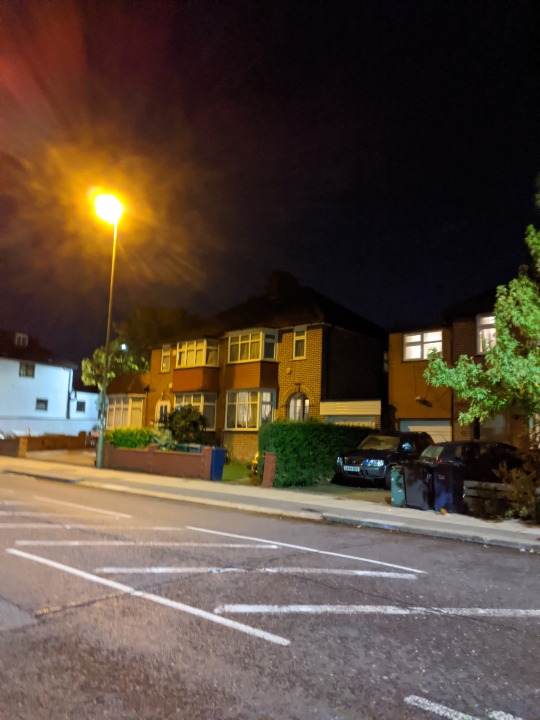

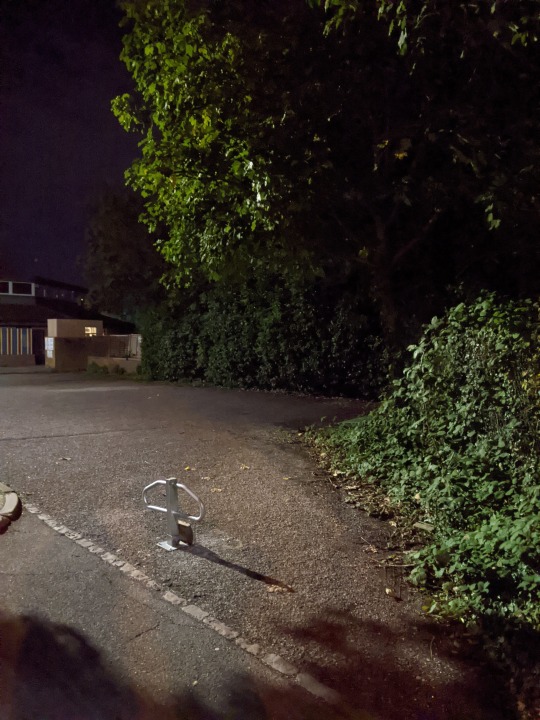
After reading “The theory of the Derive “ by Guy Debord, I decided to go on a walk at night with a friend of mine. I left the house with nothing but a tote bag, my phone and an umbrella in case it started raining, I then decided to roam around without looking at google maps. This allowed me to discover places that I have never been to and decide which path to take so I would still be in a safe location. And as I was walking I noticed how my gender affected the way I saw that walk, while my male friend wandered around with his phone on his hand and headphones on, I constantly held his hand when seeing a man walking past, or when walking near a dark place. I realized how used to I was to checking behind walls and getting scared at any sudden movement or sound behind trees and bushes. The Derive showed me how curious I was to learn more about every single house in the neighborhood I was walking by, as I was suddenly attracted by every single window in every house. While questioning myself who lived in those houses and if someday I would somehow unintentionally and unconsciously meet one of those people.
And at the end of the way, I was always drawn by the comfort of light, as I recognize the dangers of being a woman in a dangerous society.
0 notes
